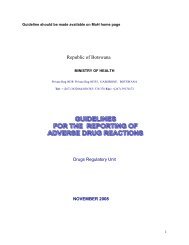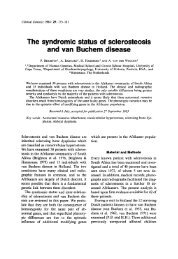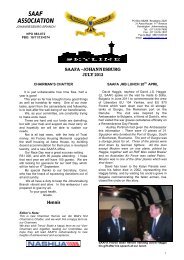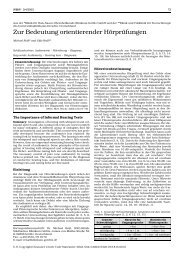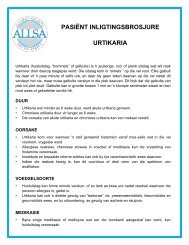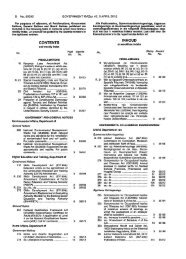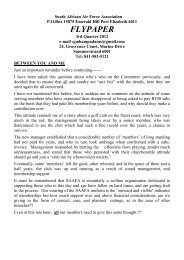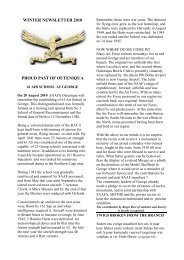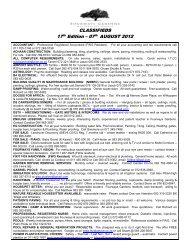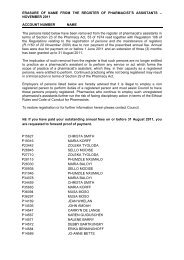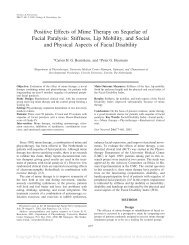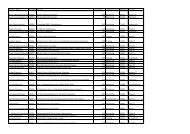Bell's Palsy: The Spontaneous Course of 2,500 Peripheral ... - Admin
Bell's Palsy: The Spontaneous Course of 2,500 Peripheral ... - Admin
Bell's Palsy: The Spontaneous Course of 2,500 Peripheral ... - Admin
Create successful ePaper yourself
Turn your PDF publications into a flip-book with our unique Google optimized e-Paper software.
Bell’s palsy 27<br />
<strong>The</strong> investigation clearly indicates that there is no<br />
difference in the sex distribution <strong>of</strong> Bell’s palsy<br />
patients.<br />
<strong>The</strong>re is no difference regarding left or right localization<br />
<strong>of</strong> Bell’s palsy.<br />
<strong>The</strong> age distribution <strong>of</strong> Bell’s palsy patients should<br />
be compared with that <strong>of</strong> the underlying population.<br />
<strong>The</strong> incidence reaches a maximum between<br />
the ages <strong>of</strong> 15 and 45 years. It is signi cantly less<br />
common below the age <strong>of</strong> 15 years and above the<br />
age <strong>of</strong> 60 years.<br />
Complete recovery was observed in 71% <strong>of</strong> all<br />
patients. Males and females recovered in the same<br />
proportions.<br />
Patients with incomplete paresis regained normal<br />
function in 94% <strong>of</strong> cases and those with complete<br />
paralysis regained normal function in 61% <strong>of</strong><br />
cases.<br />
All Bell’s palsy patients recovered to some extent:<br />
83% <strong>of</strong> all patients recovered with a fair result; 5%<br />
<strong>of</strong> patients were left with an unacceptably high<br />
degree <strong>of</strong> sequelae.<br />
Normal function was regained within 3 months in<br />
about two-thirds <strong>of</strong> all patients; after 6 months no<br />
additional patients regained normal mimical<br />
function.<br />
Sequelae were found as follows: residual paresis,<br />
29%; contracture, 17%; associated movements or<br />
synkinesis, 16%; dry eye and crocodile tears, 2%.<br />
Bell’s palsy is not more frequent in hypertensive<br />
patients and the prognosis in these patients is not<br />
worse than that in non-hypertensive patients; the<br />
connection between advanced age and hypertension<br />
would seem to be a coincidence.<br />
Pregnant women with peripheral facial nerve palsy<br />
regained normal function in 61% <strong>of</strong> cases.<br />
Paresis caused by herpes zoster was complete in<br />
88% <strong>of</strong> cases and incomplete in 12%. <strong>The</strong> prognosis<br />
for these patients is bad, with normal recovery<br />
in 21% and no recovery in 4%.<br />
Facial nerve palsy in diabetics was incomplete in<br />
62% <strong>of</strong> cases and complete in 38%. In spite <strong>of</strong> the<br />
high proportion <strong>of</strong> mild pareses the nal outcome,<br />
as a result <strong>of</strong> polyneuropathy, was poor, with only<br />
25% regaining normal function.<br />
Bell’s palsy in children is uncommon and the<br />
prognosis is excellent, with 90% regaining normal<br />
function. <strong>The</strong> non-Bell’s palsy group had different<br />
etiologies determining the prognosis. <strong>The</strong> incidence<br />
<strong>of</strong> birth trauma facial nerve paresis has decreased<br />
dramatically during the last 25 years, as a result <strong>of</strong><br />
improvements in obstetrical techniques.<br />
Bell’s palsy has the best prognosis <strong>of</strong> all peripheral<br />
facial nerve palsies.<br />
Based on the experience <strong>of</strong> this investigation it<br />
should be emphasized that clinical trials require a<br />
large number <strong>of</strong> patients in order to be valid.<br />
<strong>The</strong> facial nerve surgeon from London Sir Terence<br />
Cawthorne advised his assistants to examine facial<br />
nerve patients properly. It would be a catastrophe to<br />
diagnose facial palsy as idiopathic if the patient suffered<br />
from a severe disease:<br />
‘‘All that glitters is not gold’’ (William Shakespeare)<br />
‘‘All that palsies is not Bell’’ (Cawthorne)<br />
For more than 35 years I have studied facial nerve<br />
paralysis and have learned that close reading <strong>of</strong> the<br />
literature is crucial:<br />
‘‘To be or not to be’’ (William Shakespeare)<br />
‘‘To be skeptical’’ (Peitersen)<br />
FUTURE DIRECTIONS<br />
Regarding idiopathic peripheral facial nerve paralysis:<br />
where are we and where are we going? <strong>The</strong> focus<br />
should be on the treatment. Today’s problems are<br />
similar to those encountered in the 1950s and 1960s,<br />
when facial nerve surgeons believed in decompression<br />
operations but never provided signi cant documentation<br />
<strong>of</strong> its ef cacy. Prednisone treatment began in the<br />
1970s and increased dramatically in the 1980s and<br />
1990s, especially in the USA but less so Europe and<br />
has never really been accepted in Scandinavia. A<br />
survey <strong>of</strong> the literature today reveals at least 100<br />
trials that have reported the effectiveness <strong>of</strong> prednisone<br />
treatment. Nevertheless no trial has ful lled<br />
the requirement for a clinical, randomized, doubleblind<br />
study with a suf cient number <strong>of</strong> patients and<br />
with exact descriptions <strong>of</strong> the time <strong>of</strong> recovery and<br />
sequelae, including residual paresis, associated movements<br />
and contracture, graded after 1 year. This is a<br />
very depressing statement to make but nevertheless it<br />
is the truth.<br />
Simple electrical tests have been used to predict the<br />
degree <strong>of</strong> denervation. Based on these results the nal<br />
outcome was predicted, but this was not based on a<br />
clinical examination after 1 year. <strong>The</strong> value <strong>of</strong> electrical<br />
tests has been overestimated. If the nerve is<br />
inexcitable then Wallerian degeneration must have<br />
begun 3 days previously and the denervation has to<br />
be accepted. <strong>The</strong>re is no test available that can tell us<br />
early enough what has happened to the nerve. From<br />
this point <strong>of</strong> view any viable treatment should be<br />
begun as early as possible. But is there a drug <strong>of</strong><br />
choice? Not yet is the correct answer. Early treatment<br />
raises another problem: :80% <strong>of</strong> Bell’s palsy patients<br />
do not need treatment and it may be unethical<br />
to treat this group, given the chance <strong>of</strong> side-effects.



